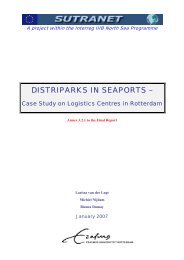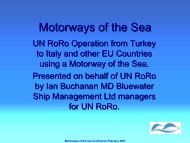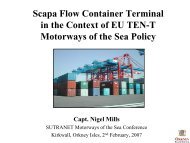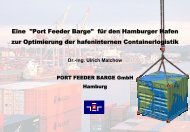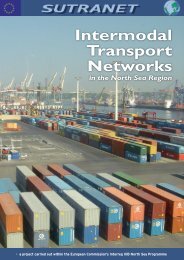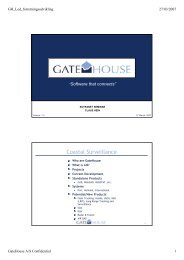TRANSPORT SYSTEMS CONCEPTS and DEFINITIONS - Sutranet
TRANSPORT SYSTEMS CONCEPTS and DEFINITIONS - Sutranet
TRANSPORT SYSTEMS CONCEPTS and DEFINITIONS - Sutranet
You also want an ePaper? Increase the reach of your titles
YUMPU automatically turns print PDFs into web optimized ePapers that Google loves.
RoRo <strong>and</strong> RoPax Vessels<br />
The ‘RoPax’ concept is related with RoRo (roll on/roll off) vessels 6 . A RoRo vessel typically<br />
carries a mixture of rolling cargo dominated by road trailers (lorries <strong>and</strong> unaccompanied semitrailers),<br />
but also containers loaded on special rilling equipment. The RoRo vessel is mainly<br />
considered as a freight ship. The term ‘RoPax’ indicates that a RoPax vessel is able to serve<br />
both passengers <strong>and</strong> freight on vehicles/trailers. It is combining the cargo capacity of a RoRo<br />
vessel with the passenger amenities of a modern ferry.<br />
Ferry Transport<br />
Ferry services could include both passengers <strong>and</strong> freight. The services are scheduled i.e. they<br />
take place according to a regular time table <strong>and</strong> are often relatively frequent.<br />
In order to qualify as a ferry route, the maritime link in question must connect overl<strong>and</strong> road<br />
<strong>and</strong>/or rail infrastructure at both ends of the route. Thus the ferry route is mainly one link only<br />
in a passenger trip or freight transport chain consisting of roads <strong>and</strong>/or railway connections at<br />
both ends.<br />
Some types of ferries (e.g. cruise ferries) serve passengers only (unaccompanied, by bus or by<br />
passenger cars), Most of the current ferry services in the NSR provide for combined<br />
passenger <strong>and</strong> freight transport onboard the same vessel (i.e. a RoPax vessel). Ferry services<br />
also appear in the form of RoRo vessels that serve goods only (lorries, unaccompanied semitrailers,<br />
railway wagons).<br />
Freight Transport Units<br />
Some relevant terms for unit loads are:<br />
TEU (or teu).<br />
A ‘TEU’ means a st<strong>and</strong>ard ‘Twenty-foot Equivalent Unit’, which is equal to one st<strong>and</strong>ard 20<br />
ft long container. A 40 ft container represents 2 TEU. One 13.6 m long st<strong>and</strong>ard trailer is also<br />
considered equivalent to about 2 TEU.<br />
Intermodal Transport Unit.<br />
An ‘Intermodal Transport Unit’ means a container, swap-body or semi-trailer suitable for<br />
intermodal transport.<br />
Cargo Transport Unit.<br />
A ‘Cargo Transport Unit’ means a freight container, swap-body, vehicle, railway wagon<br />
(‘railroad car’), or any similar unit.<br />
6<br />
The present description is based on several websites, including www.stenaroro.com; ing.dk/forum;<br />
en.wikipedia.org/Wiki/Containers; www.tropical.com; www.containerh<strong>and</strong>buch.de.<br />
6



